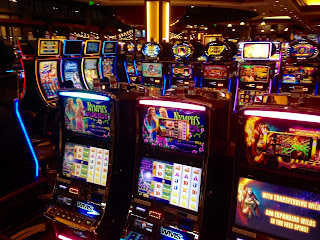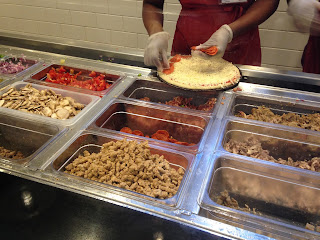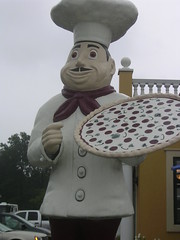Paulie
Gee's Hampden
3535 Chestnut Ave.
Baltimore
MD
In a
perverse way, Pizza Club is grateful for the logistical
complications that stalled the opening of Paulie Gee's Hampden
for lo these past three years. The resistance of the smoke-encrusted
old Republican Club building, which had to be stripped down to the bricks, helped us reflect on our own knee-jerk feelings of
resistance to the new and trendy. In the interval between proprietor
Kelly Beckham's announcement
that he would open a branch of the pioneering Brooklyn craft-pizzeria
in Baltimore and the unveiling of said local branch, we walked past
the building for weeks and months, watching it slowly metamorphose.
The
passage of time mellowed our suspicions
of parachute
Brooklyn
imperialism;
Beckham was committed to his colleagues in the local pizza scene and
to his Hampden location. Most neighbors we queried were unfamiliar
with the Brooklyn Paulie Gee's and its status as a darling
of national pizza tastemakers. The Baltimore location would have to stand on its
merits; the whole trend that it embodied had already spread locally
with venues like Verde and Hersch's working in the same vein of
finely-crafted high-end Neapolitan pies in a casual-but-classy
setting. When we finally walked through the glass doors into the
high-ceilinged dining room of Paulie Gee's Hampden, we were simply
curious to taste their pizza.
The
pizza, however, is not entirely the point. I mean, it is – this is
a business where workers devote their time to optimizing the number
of charred spots on a round slab of dough. There's like a 90% chance
that you'll eat a pie complying with the most stringent metrics of
quality. But the underlying ethos of Paulie Gee's Hampden seems to center on process, experimentation, and technical mastery, an ethos very
connected to PG's humble roots in deep pizza-nerd culture.
Indeed,
pizzas are complex interactions between humans, objects, and physical
laws. In a fast-food setting, the process is automated and
black-boxed to maximize efficiency and consistency. In a high-end
setting, the process is fetishized as the artistry of a “chef”
who has total creative control. Neither of these is correct; neither
invisible systems nor Great Men determine pizza's fate. Many contemporary theorists suggest that things are running the show.
With
its cooking area fully-exposed in the center of the space, Paulie
Gee's declares the networked nature of the human and non-human. The
ovens have individual names and dispositions; people maneuver with and
around these infernal agents, discovering their dynamic properties.
Inches, degrees, and seconds execute powerful entanglements. A fickle mixture of flour,
water, and bacteria sets the entire agenda.
Granted,
this is the start-up phase of PG's operation, so everyone is focused on learning
how to use new tools, combine ingredients, and run a restaurant. But
the spiritual essence of the place is also being formed, and at its
core is a characteristically American paradox. We want the
authenticity of time-honored Old World traditions – ovens
hand-built by Neapolitan craftsmen, meat slices that taste like
pepperoni but have fancy Italian names so you know they're legit. At
the same time, we're obsessed with innovation, optimization, and
novelty. You can actually taste this paradox in Paulie Gee's pizza.
Cognitive dissonance tastes really, really good sometimes, but its
weird moments are a reminder that we're all adrift on the same
greasy flow of global capital, grasping at signifiers of
authenticity.
The
menu itself is testimony to Paulie Gee's postmodern condition. Each pie is named with a goofy wordplay, often on a pop culture reference, concocted to make people on dates feel foolish when they order. However, beneath the celebrity puns we find perplexities. “The
toppings seem random,” Kate said of their specialty pies. Mike
concurred, “these descriptions aren't grabbing me. It all sounds
the same.” Another Mike added, “there are lots of different kinds
of pizza but not a lot of variety. If you're gonna have all these
options they should be distinctive.” PG's is assertive about not
doing gluten-free crust until they develop a recipe that meets their
standards of excellence. They do, however, offer a strong slate of
vegan pies with house-made cheese and meat replacements. At one
point, we mistook the vegan sausage for real sausage.
Over
the course of a marathon 4-hour pizzafest, Pizza Club got to sample a
wide range of pies (and we tried making some ourselves, with mixed
success). PG's workers were friendly and accommodating of our
shambling party, and we were in very good hands hospitality-wise. The
baseline, a cheese pizza (dubbed the “Regina”) featured pure and
strong flavors, a sauce made only of crushed tomatoes under a perfect
lacing of mozzarella and basil leaves. PG's Neapolitan stylings
function optimally under these simple conditions: the crust has
crunch, the moisture balance is good.
As
we ventured deeper into the specialty realm, things got soggier –
an arugula-topped pie was “a little watery, but very light and
fresh.” More maximal options, like the “In Ricotta da Vegan”
with house-made cashew ricotta and vegan sausage, were laden down
with their topping bounty. These are delicious, high-quality
toppings; more is always better in America, but they strain the
traditional delicacy of the crust.
PG's
deploys an array of flavor-infused oils and reductions to add
complexity to their pies, equivalent to what their down-market
competition
calls “afterbakes”. One Pizza Club member coined the term
“post-oven philosophy” for this trend. At PG's “Mike's
Hot Honey” is a mainstay, a spin-off product from the original
Brooklyn restaurant. Pizza Club enjoyed how this honey layers
sweetness and heat on top of salty mozzarella and tangy sauce, but
some felt that it was overkill and certain pies became cloyingly
sweet.
To
highlight hand-made ingredients from other local establishments, PG's
was offering a Blue Pit Brisket (BPB) pie. This proved controversial
in our group. Some declared it an abomination against pizza (“Nothing
is ok about this”), while others loved its “balance of sweet,
smokey, and bitter” flavors. The individual toppings were “all
good...but the sweetness [of BBQ sauce] is overpowering. I'd rather
just eat brisket,” said one Pizza Club member. A fan of the pie
deemed it “nice synergy, something that can only happen here. Well
done!”
We
recognized the BPB as a novelty pie, meant to jazz up the menu and
cure pizza fatigue by smashing together two beloved food genres.
Which is fine – that's a thing all pizza places do (see: taco
pizza, Philly cheesesteak pizza, mac and cheese pizza) and it doesn't
have to be a masterpiece for the ages. But given the great abundance
of Baltimore food-makers who pickle, smoke, jam, and ferment, we'd
hope for more considered use of local ingredients. “They get the
kind of nice things people are into – honey, mezcal, balsamic
infusions – but not how to combine them,” said one Pizza Club
member; Mike concurred, “they have the nice tools, the nice
techniques, the nice ingredients, but not the nice touch.” Faced with infinite possibilities,
it kind of feels like PG's is systematically trying out every permutation, which worked for Paul Ehrlich.
We
attest that at Paulie Gee's Hampden the practice of Neapolitan
pizza-making is being pursued at a high level of technical
proficiency. The crust is thin, crisp, and delicate, pillowing out
around the edges and characteristically spotted. Some felt that the
leopard spotting made their slices taste burned, but natural
variation is part of the deal with this style, and if you don't like
oven-char, Neapolitan might not be for you. Conceptually, Paulie
Gee's is like very serious cosplay: an enthusiastic, obsessive,
sometimes-artless appropriation of a thing that it recognizes it did
not create and does not own. For Paulie Gee the man, pizza was an
elective affinity cultivated through the internet. As in cosplay,
there's a sheer joy that comes with giving this affinity concrete
form, enmeshing it within the world of vital materials.
In
short: the cost of PG's craftsmanship runs from $8 to $18 for a
specialty pizza that feeds two moderately-hungry people. There is
variability from pie to pie, both in terms of how they're cooked and
the success of the ingredient combinations. These variations will
fall below the noticeability threshold for most patrons, who will
find a similar experience to other local mainstays of Neapolitan
style. Pizza lovers who pay special attention will have the unique
pleasure of participating in a living experiment. “In 20 years,”
said Mark, “they might have the perfect pizza. Or maybe 2 years,
who knows. It's kind of exciting because you can watch their craft
grow. It's very ambitious.” Paulie Gee's offerings may not cohere
into a culinary vision, but that's because its model favors process,
enthusiasm, and technique over authorship, a practice-based
approach to pizza and networked modernity.
6.5/8
slices
Photo credits: Graham































